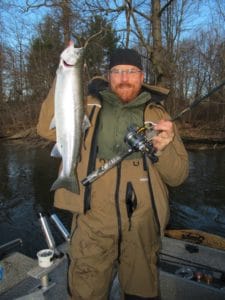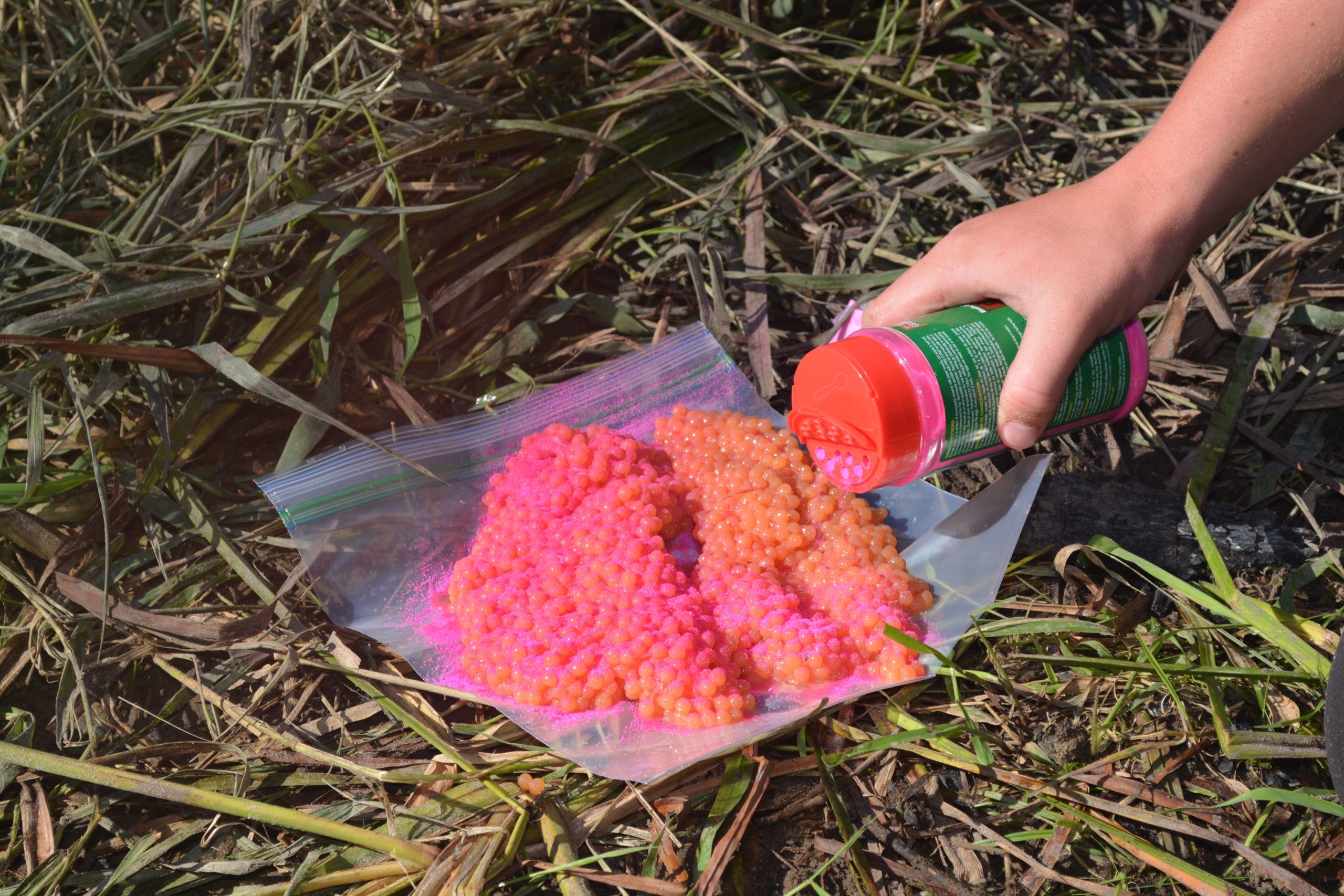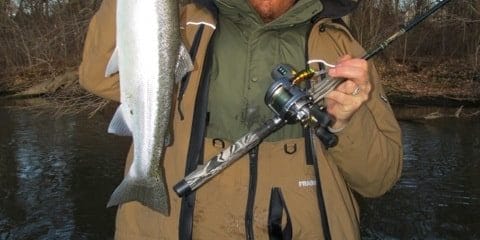By Dave Mull
While, strong, acrobatic steelhead attract expert anglers using specialized techniques, knowing some simple basics will help an angler’s odds of success.

The author makes fall steelhead fishing a priority even during a season when there are so many great hunting and fishing options. He says a wiggling crankbait fished through a fish-holding section of river will often produce a memory like this.
Many Great Lakes tributaries offer terrific fishing for steelhead from mid-summer, through winter and into spring, and many anglers who could be cashing in on the fun don’t realize what they’re missing.
Steelhead are Pacific ocean, sea-run rainbow trout that, through stocking and natural reproduction, have become permanent residents of all five Great Lakes. Born or stocked in streams, they eventually head to the big water to feed and grow before returning rivers to spawn. Unlike salmon, which die after they spawn, steelhead spawn and then return to the lake to feed. Steelhead then run the rivers to spawn again, repeating the cycle.
They are a beautiful, rainbow-trout-colored species that deliver a spectacular tussle that includes awe-inspiring jumps when hooked in any body of water, especially shallower streams and rivers, and they can grow up to 20 pounds and bigger.
Different strains of the species come into the rivers from mid-summer to late winter, but all spawn in the spring. Unfortunately, they have taken on an almost mythical reputation of needing specialized equipment and finely tuned presentations, but chances are, if you fish for bass and panfish, you have enough gear to hook and land some stream and river steelhead, too.
When targeting steelhead in moving water, success comes from one of two basic approaches: You put something big and (and usually colorful) in the fish’s faces and provoke a reaction strike. Or, you present a smaller, more natural bait that the steelhead wants to eat.
Reaction Strikes
Any bass angler who understands where smallmouth hang out of the current will be able to use that knowledge to hook up with steelies. They like staying in the same kinds of places out of the current.
Most Great Lakes steelhead are conditioned to eat long, slim baitfish such as shiners and alewives on the big water, and they will often hit slim, hard-plastic stickbaits cast while wading or from a boat. Lures such as Smithwick Rogues, Normark Floating Rapalas and Storm Thundersticks are all good choices. Simply cast them into little pockets of slack water behind logs and rocks, and in eddies along the shoreline.
Crankbaits such as Storm Wiggle Warts and Hot-N-Tots, the Yakima Mag Lip and Luhr-Jensen Kwikfish all can get a steelhead to strike, especially when trolled in the current, or let out from an anchored boat, allowed to wiggle slowly, backwards, downstream. These lures target fish that have found small depressions on the bottom where they don’t have to expend a lot of energy fighting currents. To perform the “anchored drop-back,” the angler simply stands at the back of the anchored boat and lets out line until the lure is ticking bottom. Then, either more line is let out from the reel, or more anchor rope is let out from the boat. The idea is to put a wiggling lure right in a fish that’s on the bottom, facing upstream.
Natural Finesse
The other side of the steelhead coin is catching them with bait: mayfly nymphs (aka “wigglers”), waxworms, minnows and prepared salmon and steelhead eggs are among the natural baits with proven track records. Here, the object is to mimic natural foods that the current carries into the fish’s lair. The easiest way to do this is with a bobber, bait suspended below, that is allowed to drift close to the same speed as the current. A key is to peg the bobber just far enough above the bait to keep the presentation drifting within a few inches of the bottom, as the quarry will usually be hugging the streambed.
Egg Care

Steelhead eggs are a great steelhead bait, and the best place to get eggs is from a hen steelhead that you harvest. Be sure to cure the eggs properly.
Possibly the most reliable bait for steelhead are steelhead eggs, and the best place to get eggs is from a hen steelhead that you harvest.
To gather your own eggs, bleed the fish by cutting its gills—keep the fish in the water. This quickly dispatches the fish and removes excess blood from the eggs as blood can make them spoil more quickly and add a scent that steelhead don’t like.
Harvest the eggs and put them in a Ziploc bag, keeping them cold until you can treat them with one of the brine powders available on the market. Treating them is an easy, though slightly involved process. A good resource is scent and cure manufacturer Pro-Cure, which offers great advice on its pro-cure.com website.
Properly cured eggs stay on your hook better, they have added, fish-attracting scent, and they can last a month in your refrigerator and a year in your freezer.
Tackle
I caught my first steelhead one November afternoon more than three decades ago in a golf course creek, armed with my dad’s 7-foot fiberglass spinning rod that he favored for bass fishing. The bait was a spawn bag on a No. 4 hook, suspended below a wooden bobber that had seen use for bluegills the previous summer. The reel was my dad’s classic Garcia-Mitchell 300, spooled with inexpensive 10-pound test monofilament. That sort of set-up works fine for casting or trolling, too. It really doesn’t take much of anything fancy to get started.
Be forewarned, though: Steelhead can become a powerful obsession, and after you catch a few, you might find yourself—credit card next to your computer—on-line and browsing such things as center-pin reels and the outrageously expensive rods that go with them. Or, even worse for your savings account, you might end up in a boat dealership, shopping for jet-drive aluminum boats to ply some of magnificent rivers that steelhead make their winter homes.
That’s okay. Most anglers inducted into the society of steelhead fanatics agree: Steelhead are quite worth it.
The Union Sportsmen’s Alliance website is designed to provide valuable articles about hunting, fishing and conservation for members of AFL-CIO affiliated labor unions and all sportsmen and sportswomen who appreciate hunting and fishing and want to preserve our outdoor heritage for future generations. If you would like your own story and experience from the outdoors to be considered for our website, please email us at [email protected].








